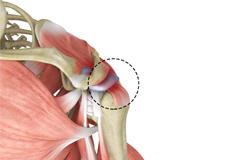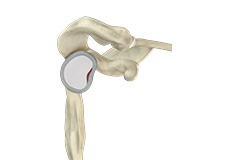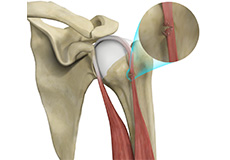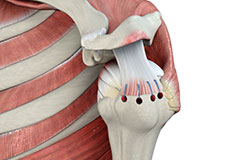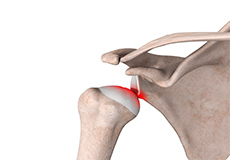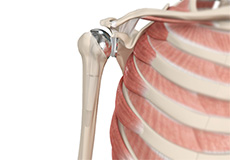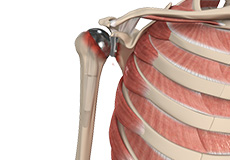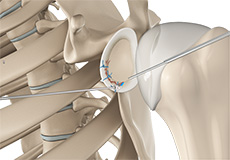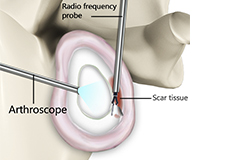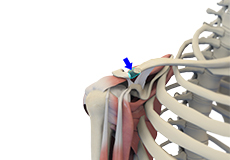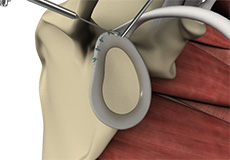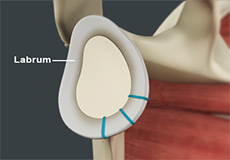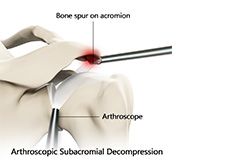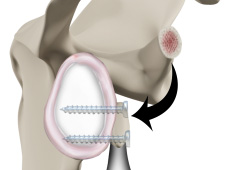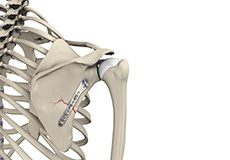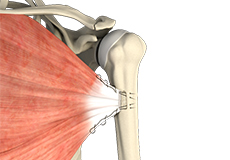Dr. Cancienne specializes in injuries and treatments for all shoulder conditions and ailments. He spent a significant portion of his specialty training focusing on shoulder disorders in patients of all ages and activity levels, including professional athletes. His interest in the shoulder goes beyond treating patients in the clinic and the operating room, as evidenced by his contribution of more than 30 peer reviewed publications and numerous presentations given on various shoulder pathologies.
The shoulder is the most flexible joint in the human body, and allows us to throw, reach, grab, push and pull with great force. However, due to its flexibility and inherent instability, it requires the support of ligaments, muscles, and tendons to provide us with functional stability.
Bones
The shoulder is made up of three major bones: the humerus, scapula, and clavicle.
Humerus: The upper end of the humerus forms the ball of the shoulder joint. This is where the rotator cuff tendons insert. The upper end of the humerus contains softer bone that the remainder of the bone, and is therefore more prone to fracture or breaking.
Scapula and Clavicle: The scapula is also known as the shoulder blade. It is a flat shaped bone and serves as the site of attachment for the majority of muscles that allow us to move our arm away from the body. Also, the scapula contains the glenoid, which is the socket for the ball in the shoulder. The shoulder joint is analogous to a golf ball and a golf tee, where the tee is the glenoid and ball is the humeral head. The ball is much larger than the head, allowing great range of motion at the expense of stability. Thus, the shoulder is the most commonly dislocated joint in the body.
The clavicle or collarbone is an S-shaped bone that connects the shoulder to the sternum or breastbone. The far end of the clavicle helps to create the acromioclavicular or AC joint, and the medial end of the clavicle forms the sternoclavicular joint. The clavicle is a common broken bone in patients who sustain trauma from falls, including biking and football amongst other activities.
Soft Tissues of the Shoulder:
Ligaments: ligaments are thick bands of tissue that connect two bones together. The ligaments of the shoulder include the coracoclavicular ligaments which provide stability to the clavicle or collarbone, the acromioclavicular ligament which helps to stabilize the AC joint, and the glenohumeral ligaments. These are 3 important ligaments that help keep the shoulder ball within the socket. When the shoulder is dislocated, these ligaments may be torn and require repair to restore stability to the shoulder joint.
Muscles of the Shoulder:
The rotator cuff muscles are some of the most commonly injured and symptomatic muscles in the body. The rotator cuff complex is composed of 4 muscles: the supraspinatus, infraspinatus, subscapularis, and teres minor. These strong muscles originate on the scapula and insert onto the ball of the humerus. They allow us to move our arms away from our body with strength and speed. Dr. Cancienne has performed important clinical research on the injury patterns, healing ability, and risk factors for failure following treatment for rotator cuff injuries.
Biceps Tendon
The long head biceps tendon is attached to what we know as our “Popeye” muscle on the anterior aspect of the arm. The musculature portion seen turns into a tendon as it travels towards the shoulder joint, where it ultimately attaches to the superior portion of the shoulder socket. The biceps tendon can become inflamed, resulting in significant pain with shoulder motion.
Dr. Cancienne hopes you have found this brief review of shoulder anatomy helpful and informative. For more information on specific pathologies and treatment strategies, please click on the Services heading and select the Shoulder section, or request an appointment.
Rotator Cuff Pain
The rotator cuff consists of a group of tendons and muscles that surround and stabilize the shoulder joint. These tendons allow a wide range of movement of the shoulder joint across multiple planes. Irritation or injury to these tendons can result in rotator cuff pain.
Rotator Cuff Tear
A rotator cuff is a group of tendons in the shoulder joint that provides support and enables a wide range of motion. A major injury to these tendons may result in rotator cuff tears.
Shoulder Instability
Shoulder instability is a chronic condition that causes frequent dislocation of the shoulder joint.
Shoulder Labral Tear
Traumatic injury to the shoulder or overuse of the shoulder (throwing, weightlifting) may cause the labrum to tear. In addition, aging may weaken the labrum leading to injury.
Bicep Tendon Rupture at Shoulder
The biceps muscle is present on the front of your upper arm and functions to help you bend and rotate your arm. The biceps tendon is a tough band of connective fibrous tissue that attaches your biceps muscle to the bones in your shoulder on one side and the elbow on the other side.
Shoulder Arthroscopy
Arthroscopy is a minimally invasive diagnostic and surgical procedure performed for joint problems. Shoulder arthroscopy is performed using a pencil-sized instrument called an arthroscope. The arthroscope consists of a light system and camera that projects images of the surgical site onto a computer screen for your surgeon to clearly view.
Rotator Cuff Repair
The rotator cuff is a group of tendons and muscles in the shoulder joint providing support and enabling a wider range of shoulder motion. Injury to the rotator cuff may occur due to pressure on the rotator cuff from part of the shoulder blade (scapula). It may occur due to repeated use of the arm for overhead activities or while playing sports.
Arthroscopic Shoulder Stabilization
Shoulder stabilization surgery is performed to improve stability and function to the shoulder joint and prevent recurrent dislocations. It can be performed arthroscopically, depending on your particular condition, with much smaller incisions. Arthroscopic stabilization is a surgical procedure to treat chronic instability of the shoulder joint.
Shoulder Joint Replacement
Total shoulder replacement surgery is performed to relieve these symptoms. In this surgery, the damaged articulating parts of the shoulder joint are removed and replaced with artificial prostheses. Replacement of both the humeral head and the socket is called a total shoulder replacement.
Reverse Total Shoulder Replacement
Conventional surgical methods such as total shoulder joint replacement have been shown to be significantly ineffective in the treatment of rotator cuff arthropathy. Reverse total shoulder replacement is an advanced surgical technique specifically designed for rotator cuff tear arthropathy, a condition where you suffer from both shoulder arthritis and a rotator cuff tear.
Revision Shoulder Replacement
Total shoulder replacement usually has good results, but a revision surgery may occasionally be necessary due to persistent pain, infection, stiffness, weakness, instability, hardware loosening, malposition or fracture.
Arthroscopic Bankart Repair
The labrum can sometimes tear during a shoulder injury. A specific type of labral tear that occurs when the shoulder dislocates is called a Bankart tear. This is a tear to a part of the labrum called the inferior glenohumeral ligament and is common in the young who sustain a dislocation of the shoulder.
Arthroscopic Capsular Release
A capsular release is a surgery to release a tight and stiff shoulder capsule, a condition called frozen shoulder or adhesive capsulitis. The procedure is usually performed arthroscopically through keyhole-size incisions.
Arthroscopic Distal Clavicle Excision
Distal clavicle excision is a procedure which involves removal of the outer end of the clavicle (collarbone) to treat shoulder pain and disability due to arthritis or impingement.
Arthroscopic SLAP Repair
A superior labrum anterior and posterior tear or SLAP tear is an injury to the labrum. This injury may also involve the biceps tendon, which is attached to the top part of the labrum. The injury occurs from repeated use of the shoulder while throwing or a fall onto the shoulder.
Shoulder Labrum Reconstruction
The shoulder joint is a ball and socket joint. A ball at the top of the upper arm bone (the humerus) fits neatly into a socket, called the glenoid, which is part of the shoulder blade (scapula). The labrum is a ring of fibrous cartilage surrounding the glenoid, which helps in stabilizing the shoulder joint.
Arthroscopic Subacromial Decompression
Subacromial decompression is a surgical procedure performed for the treatment of a condition called shoulder impingement. In shoulder impingement, the degree of space between the rotator cuff tendon and shoulder blade is decreased due to irritation and swelling of the bursa or due to development of bone spurs.
Latarjet Procedure
The shoulder joint provides a wide range of movement to the upper extremity, but overuse or trauma can cause instability to the joint. The Latarjet procedure is a surgical procedure performed to treat shoulder instability by relocating a piece of bone with an attached tendon to the shoulder joint.
ORIF of the Scapula Fractures
ORIF/open reduction and internal fixation is a surgical procedure employed for the treatment of a scapula fracture not amenable to non-surgical conservative treatment.
Pectoralis Major Tears/Repairs
The pectoralis muscle is a large fan-shaped muscle comprised of the pectoralis major and pectoralis minor muscles that stretch from the armpit to the collarbone and down across the lower chest region on both sides of the chest. The two sides of the chest connect at the breastbone or sternum.


